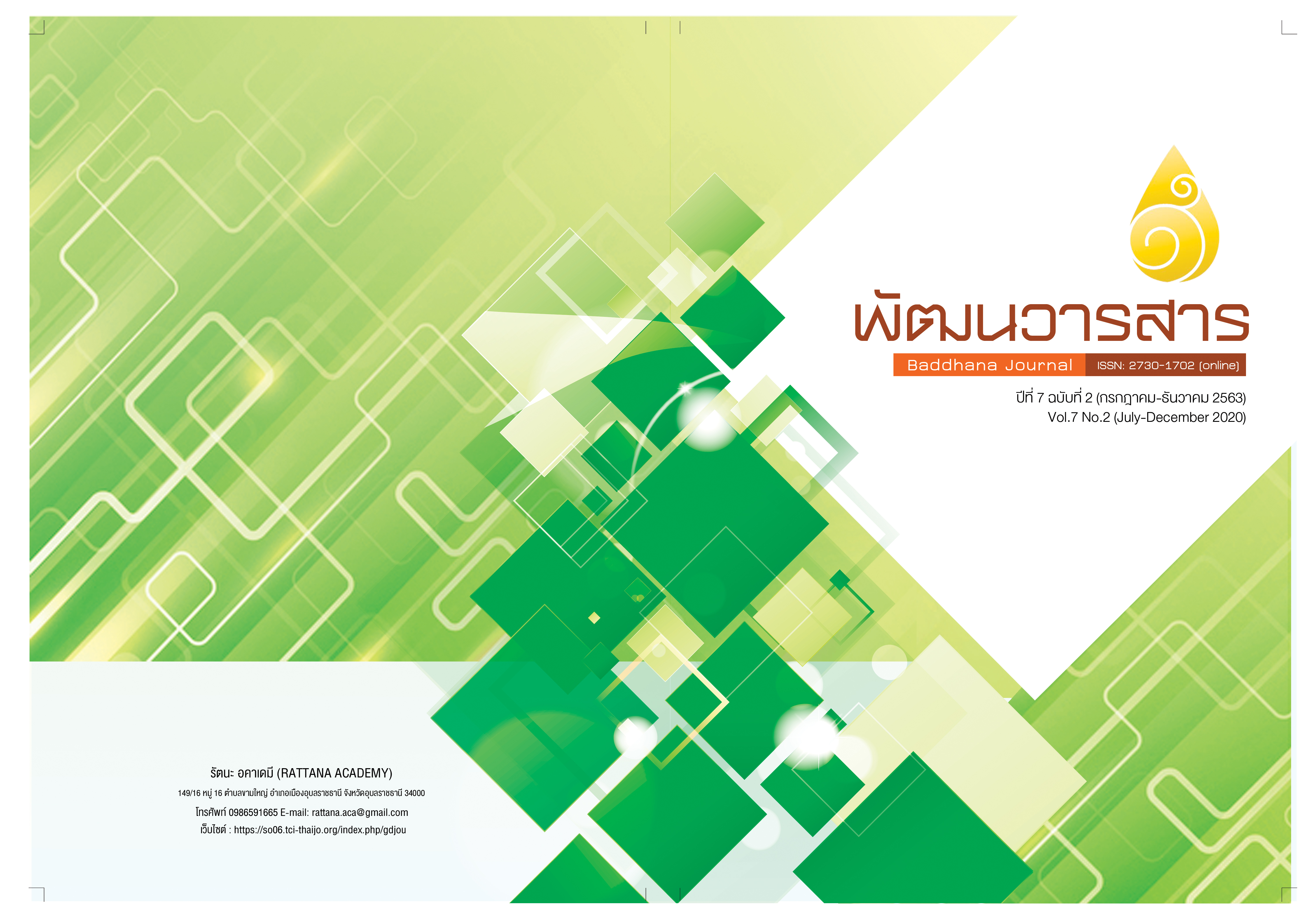ENVIRONMENTAL MANAGEMENT OF FACTORIES IN MAP TA PHUT INDUSTRIAL ESTATE PROBLEMS OBSTACLES AND SOLUTIONS
Main Article Content
Abstract
The objectives of this research were to study: study the process of environmental management of factories in Map Ta Phut Industrial Estate problems and obstacles in the environmental management of factories in Map Ta Phut Industrial Estate by the researcher using Qualitative research with In-depth interview and check the quality of Triangulation data. The key informants were divided into 3 groups, consisted of chief executive middle managers and officers, with a total of 48 people. Data were analyzed using descriptive analysis methods. According to this study, it was found that most companies have management plans for prevention, disruption plan, and environmental rehabilitation plan, adopting the ISO 14000 principle and applying the Emergency plan in environmental management and try to promote two-way communication throughout the organization, along with raising awareness for the employees to take care of the environment, most personnel developments used training, development of skills and expertise in operations and continuous work process checking.
As a result of the study, it was found that environmental management still had important problems and obstacles, such as unclearness in the preparation of accident prevention plans, suppressing incidents, or remedies. As well as the content and methods of implementing the plan in all 3 aspects. Also, the plan was still lacking participation from stakeholders such as relevant agencies and communities and including the lack of external communication, especially in the communities surrounding the industrial estates. In aspect of creating awareness among personnel, it was found that there was no evaluation of the success of personnel with environmental awareness, and still unable to assess whether employees have knowledge and skills in managing problems in accordance with prevention plans, suspension plan and the remediation plan, however, the aspect of work process adjustment, it was found that the lack of new technology for production to reduce environmental impact and modifying the use of modern machines was still very little, the aspect of implementation of the plan, it was found that there was a lack of coordination of operations and systematic work procedures, the aspect of continuation of the implementation of the plan, it was found that lack of push in level of policy and the lack of continuation of the plan, the aspect of the plan review, it was found that there were no reports of prevention plans, suspension plans, remedies and rehabilitation plans for the community and stakeholders to know directly.
From the above problems and obstacles, there were important suggestions as follows: 1) The organization must clearly specify policies, prevention plans, suspension plans and remedies, including the Industrial Estate Authority of Thailand should set policies or enforce the group of Map Ta Phut Industrial Estate must have clear prevention plans, suspension plans and remedies; 2) Industrial plants must promote and support participation in all sectors to play a greater role in participation in the planning; 3) Industrial plants must communicate to the public and interested persons about prevention plans, suspension plans and remedies; 4) Industrial plants must create awareness of work quality and organizational consciousness together; 5) Industrial plants should recruit persons with knowledge, ability and experience in the operation and suitable to work according to prevention plans, suspension plans and remedies; 6) Industrial plants should use green industry methods, through good management and correct work practices, including process modification; 7) Industrial plants should adopt PDCA cycle management principles in their operations to be result and effective; 8) Industrial plants must be driven at the policy level for continuity of activities of prevention plans, suspension plans and remedies; 9) Industrial plants must submit a prevention plan report, suspension plans and remedies for the community and stakeholders to know directly; and 10) Industrial plants must adopt PDCA cycle management principles for improvement, prevention and solving the problems.
Article Details
References
กรมควบคุมมลพิษ. (2558). รายงานสถานการณ์มลพิษของประเทศไทย พ.ศ. 2558. (ออนไลน์) เข้าถึงได้จาก http://www.pcd.go.th/public/Publications/print_report.cfm?task=pcdreport2558
กรมส่งเสริมคุณภาพสิ่งแวดล้อม. (2552). สาร VOCs ประกอบอินทรีย์ระเหยง่ายในดินและน้ำใต้ดิน ส่วนวิจัยและพัฒนาเทคโนโลยีด้านน้า ศูนย์วิจัยและฝึกอบรมด้านสิ่งแวดล้อม. (ออนไลน์) เข้าถึงได้จาก http://www.environnet.in.th/evdb/info/knowledge/download
การนิคมอุตสาหกรรมแห่งประเทศไทย. (2557). แผนปฏิบัติการภาวะฉุกเฉิน กลุ่มนิคมอุตสาหกรรมและท่าเรืออุตสาหกรรมพื้นที่มาบตาพุด จังหวัดระยอง. (ออนไลน์) เข้าถึงได้จาก http://www.mtpie.com/www/UPDATE102014-032015/DOWNLOAD/ERP-2557.pdf
กริช สืบสนธ์. (2537). วัฒนธรรมและพฤติกรรมการสื่อสารในองค์กร. กรุงเทพ: จุฬาลงกรณ์ มหาวิทยาลัย.
เครือข่ายธุรกิจร่วมรับผิดชอบต่อสังคมไทย. (2555). ซีเอสอาร์คืออะไร. (ออนไลน์) เข้าถึงได้จาก http://www.thaicsr.com/2006/03/ blog-post_20.html
จังหวัดระยอง. (2559). แผนปฏิบัติการเพื่อลดและขจัดมลพิษในเขตควบคุมมลพิษ จังหวัดระยอง พ.ศ. 2560-2564. ระยอง. จังหวัดระยอง.
จิตติมา อัครธิติพงศ์. (2556). เอกสารประกอบการสอน รหัส 3563404 วิชาการพัฒนาทรัพยากรมนุษย์ Human resource development. พระนครศรีอยุธยา: มหาวิทยาลัยราชภัฏพระนครศรีอยุธยา
เฉลียว พลวิเศษ. (2551). การส่งเสริมการมีส่วนร่วมของภาคประชาชนต่อการจัดการทรัพยากรธรรมชาติภายใต้กฎหมายที่เกี่ยวกับสิ่งแวดล้อม หลักสูตรผู้บริหารกระบวนการยุติธรรมระดับสูง รุ่นที่ 11. กรุงเทพฯ: กระทรวงยุติธรรม.
ถวิลวดี บุรีกุล. (2548). การมีส่วนร่วม แนวคิด ทฤษฎีและกระบวนการ. นนทบุรี: พาณิชพระนคร.
นันทวรรณ วิจิตรวาทการ. (2553). โครงการการศึกษาผลกระทบต่อสุขภาพจากอุตสาหกรรม. กรุงเทพฯ: สำนักงานกองทุนสนับสนุนการวิจัย (สกว.).
นิคมอุตสาหกรรมมาบตาพุด. (2559). แผนที่นิคมอุตสาหกรรมมาบตาพุด. (ออนไลน์) เข้าถึงได้จาก https://www.google.co.th/search?q.&source=
นิตยสารModern Manufacturing.(2560).การสอบสวนอุบัติเหตุ อีกหนึ่งวิธีปฏิบัติเพื่อทราบสาเหตุพื้นฐาน.(ออนไลน์) เข้าถึงได้จาก https://www.mmthailand.com
นิศาชล หังสวนัส. (2546). ชุมชนกับผลกระทบของการพัฒนาอุตสาหกรรมมาบตาพุต จังหวัดระยอง. ปัญหาพิเศษรัฐประศาสนศาสตรมหาบัณฑิต, สาขาวิชานโยบายสาธารณะ, บัณฑิตวิทยาลัย, มหาวิทยาลัยบูรพา.
ปาริชาติ สังขทิพย์. (2546). ความคิดเห็นเกี่ยวกับผลกระทบจากโรงงานอุตสาหกรรมส่งผลต่อชุมชนแหลมฉบัง จังหวัดชลบุรี. ปัญหาพิเศษรัฐประศาสนศาสตรมหาบัณฑิต, สาขาวิชา การบริหารทั่วไป, บัณฑิตวิทยาลัย, มหาวิทยาลัยบูรพา.
ไพรินทร์ ชูโชติถาวร. (2554). บทความทางวิชาการ ครั้งที่ 1 มาบตาพุด บทเรียนการพัฒนาอุตสาหกรรม. (ออนไลน์) เข้าถึงได้จาก http://www.mtp.rmutt.ac.th/wp-content/uploads/2011/05/6
ภูธฤทธิ์ วิทยานุรักษ์รักษาศิริ, (2556). รายงานผลโครงการพัฒนาบุคลากร ศูนย์วิทยพัฒนา มสธ.สุโขทัย. (ออนไลน์) เข้าถึงได้จาก www.stou.ac.th/Offices/rdec/sukhothai/main/Km53/Km56/ 1_56.pdf+&cd=1&hl =th&ct=clnk&gl=th
วรเดช จันทรศร. (2547). รัฐประศาสนศาสตร์: จากอดีตสู่อนาคตของการวิจัยในการพัฒนาการบริหารราชการแผ่นดิน. กรุงเทพฯ: สหายบล็อกและการพิมพ์.
วรภัทร์ ภู่เจริญ. (2544). แนวทางการประเมินคุณภาพภายในสถานศึกษา. กรุงเทพฯ: สถาบันส่งเสริมการประเมินคุณภาพและมาตรฐานการศึกษาแห่งชาติ.
วรรณนภา วามานนท์. (2561). การบริหารการปราบปรามการทุจริตระดับชาติของไทย: การศึกษาบทบาท ระบบ และการบริหาร ของคณะกรรมการป้องกันและปราบปรามการทุจริตแห่งชาติ. ปรัชญาดุษฎีบัณฑิต, สาขาวิชารัฐประศาสนศาสตร์, บัณฑิตวิทยาลัย, มหาวิทยาลัยรามคำแหง.
วันรักษ์ มิ่งมณีนาคิน. (2531). การพัฒนาชนบทไทย. กรุงเทพฯ: โรงพิมพ์มหาวิทยาลัยธรรมศาสตร์.
ศูนย์วิจัยและจัดการคุณภาพอากาศมหาวิทยาลัยเชียงใหม่. (2554). รายงานการทบทวนวรรณกรรมมลพิษทางอากาศจากภาคอุตสาหกรรมและการจัดการ. เชียงใหม่: มหาวิทยาลัยเชียงใหม่
สงกรานต์ ป้องบุญจันทร์. (2555). โครงการนิติธรรมสิ่งแวดล้อม มาตรการทางกฎหมายเพื่อแก้ไขปัญหามลพิษในพื้นที่มาบตาพุด. (ออนไลน์) เข้าถึงได้จาก http://www.mtp.rmutt.ac.th/wp-content/uploads/2011/05/59
สมชาย มุ้ยจีน. (2557). แนวทางการพัฒนาเมืองอุตสาหกรรมเชิงนิเวศในพื้นที่เทศบาลเมือง มาบตาพุด. วิทยานิพนธ์วิทยาศาสตรมหาบัณฑิต, สาขาวิชาการจัดการสิ่งแวดล้อม, คณะพัฒนาสังคมและสิ่งแวดล้อม,สถาบันบัณฑิตพัฒนบริหารศาสตร์.
สมศักดิ์ ทางทอง. (2544). ผลกระทบของโครงการพัฒนาพื้นที่ชายฝั่งทะเลภาคตะวันออกที่มีต่อประชาชนจังหวัดระยอง: กรณีศึกษาตำบลมาบตาพุด. (ออนไลน์) เข้าถึงได้จาก http://www.stou.ac.th/Schools/Sec/ejournal6-2/file/1-3-1.pdf
สำนักงานคณะกรรมการพัฒนาการเศรษฐกิจและสังคมแห่งชาติ. (2551). แผนพัฒนาพื้นที่บริเวณชายฝั่งทะเลตะวันออก. (ออนไลน์) เข้าถึงได้จาก http://esdps.nesdb.go.th/sdps/
สำนักงานคณะกรรมการพัฒนาการเศรษฐกิจและสังคมแห่งชาติ. (2555). แผนพัฒนาบุคลากร (Human resource development plan). (ออนไลน์) เข้าถึงได้จาก https://www.nesdb.go.th › ewt_dl_link
สำนักงานคณะกรรมการพัฒนาการเศรษฐกิจและสังคมแห่งชาติ. (2556). แผนกลยุทธ์สำนักงานคณะกรรมการพัฒนาการเศรษฐกิจและสังคมแห่งชาติ 2556-2560. กรุงเทพฯ: สำนักงานคณะกรรมการพัฒนาการเศรษฐกิจและสังคมแห่งชาติ.
สำนักงานคณะกรรมการพัฒนาระบบราชการ. (2551). แผนยุทธศาสตร์การพัฒนาระบบ ราชการไทย (พ.ศ. 2551-พ.ศ. 2555). กรุงเทพฯ: ภารกิจการเผยแพร่และสนับสนุน การมีส่วนร่วมในการพัฒนาระบบราชการ สำนักงาน คณะกรรมการพัฒนาระบบราชการ.
สิทธิชัย ตันศรีสกุล. (2553). ปัจจัยที่ส่งผลต่อการพัฒนาชุมชนยั่งยืน กรณีศึกษาองค์กรปกครอง ส่วนท้องถิ่น จังหวัดมหาสารคาม. วารสารช่อพะยอม, 21, 51-68.
อภิชา ประกอบเส้ง. (2555). CSR Corporate Social Responsibility การดำเนินธุรกิจด้วยความรับผิดชอบต่อสังคม. (ออนไลน์) เข้าถึงได้จาก http://colacooper.blogspot.com/2012/09/ csr-corporate-social-responsibility_18.html
Weinberger, L. (1998). Commonly held theories of human resource development. Human Resource Development International, 1(1), 75-79.


